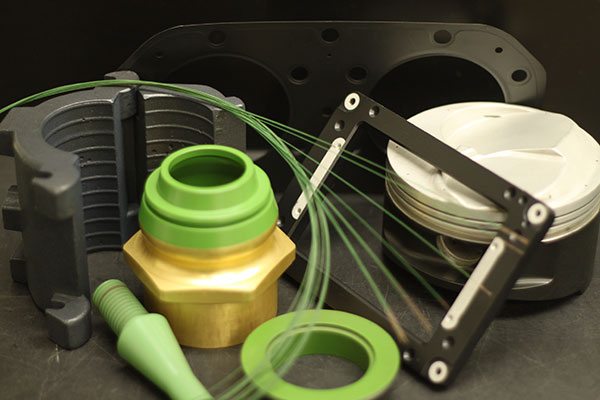
The Evolution of Teflon Coating Technology
Teflon coatings have become a cornerstone in industrial manufacturing thanks to their exceptional non-stick, chemical-resistant, and heat-tolerant properties. What began as a scientific accident in the 20th century is now a critical solution across industries such as aerospace, automotive, electronics, and food processing.
In this post, we break down how Teflon coating technology has evolved, moving from basic applications to advanced industrial systems, while highlighting why it’s still one of the most in-demand coatings today.
The Accidental Discovery That Changed Materials Science
In 1938, chemist Roy Plunkett discovered polytetrafluoroethylene (PTFE) while working at DuPont. He was experimenting with tetrafluoroethylene gas (TFE) for refrigerants when he found that it had polymerized into a white, waxy solid inside a pressurized cylinder.
This new substance had three standout properties:
- Very low surface friction
- High chemical resistance
- Thermal stability
By 1945, DuPont had patented the material and trademarked the name Teflon. Although it didn’t look like much at the time, it went on to transform multiple industries.
Early Applications: Military and Industrial Use
During World War II, PTFE found its first large-scale application in the Manhattan Project, where it was used to coat equipment that handled highly corrosive uranium hexafluoride gas. Its resistance to chemical attack and high temperatures made it invaluable.
In the post-war years, Teflon coatings were gradually introduced to commercial and industrial applications:
- Gaskets and seals in chemical processing
- Wire insulation in electronics
- Bearings and slides in mechanical systems
However, the early material had limitations as it was difficult to apply, and processing temperatures were high. This led to the next phase of innovation.
Expansion of Teflon Coating Variants
To improve performance and processability, manufacturers developed different forms of fluoropolymer resins. These included:
- FEP (Fluorinated Ethylene Propylene) – Melt-processable with better flexibility; useful for wire coatings and tubing.
- PFA (Perfluoroalkoxy Alkane) – Offers improved thermal and chemical resistance; ideal for semiconductor and chemical applications.
- ETFE (Ethylene Tetrafluoroethylene) – UV-resistant and mechanically tough; used in architectural films and aerospace.
These variants allowed for more diverse applications, especially where traditional PTFE was too rigid or difficult to process.
Advances in Application Technology
While the material itself evolved, so did the method for its application to substrates. Early on, applying PTFE coatings required complex sintering and could only be done on certain metals. Over time, application processes became more refined and adaptable:
- Spray coatings: Allowed for thin, uniform layers on a wide range of shapes and materials.
- Powder coatings: Provided thicker, more wear-resistant finishes for industrial machinery.
- Multi-coat systems: Combined primers, mid-layers, and topcoats for better adhesion and durability.
Today, Teflon coatings can be applied to aluminum, stainless steel, carbon steel, and even certain plastics and ceramics, making it one of the most versatile coating systems available.
Environmental Regulations and Reformulations
In the early 2000s, concerns emerged around the environmental impact of PFOA (perfluorooctanoic acid), a processing aid used in traditional PTFE production. In response:
- Major manufacturers participated in the EPA’s PFOA Stewardship Program, agreeing to phase out the substance by 2015.
- GenX and other alternatives were introduced as safer processing agents.
- Coating producers began prioritizing low-VOC, low-emissions systems to meet evolving environmental standards.
These changes helped align Teflon coating technologies with stricter environmental and occupational safety guideline, without sacrificing its performance.
Modern-Day Uses and Innovations
Today, Teflon coatings are more advanced, durable, and specialized than ever. At Crest Coating, we work with customers across industries to meet specific functional needs. Applications now include:
- Food Processing Equipment – Non-stick surfaces that are FDA-compliant and easy to clean
- Chemical Handling Systems – High resistance to corrosive agents and extreme temperatures
- Aerospace Components – Lightweight coatings with excellent thermal and friction resistance
- Medical Devices – Biocompatible, low-friction surfaces for implants and instruments
- Automotive and Industrial Machinery – Long-wear coatings that reduce maintenance and extend service life
Newer innovations also include reinforced PTFE composites, electrically conductive coatings, and color-customized systems, all allowing engineers and designers to meet both functional and aesthetic goals.
What’s Next for Teflon Coatings?
The future of Teflon coating technology is focused on sustainability, customization, and performance under extreme conditions. Some current areas of R&D include:
- Nano-engineered coatings for improved wear and temperature resistance
- Hybrid materials combining PTFE with ceramics or metallics
- Sustainable production processes with reduced environmental impact
As industrial demands increase, especially in sectors like EVs, clean energy, and high-speed manufacturing, PTFE-based coatings are expected to remain a go-to solution for solving performance and durability challenges.
Wrapping Up
From a lab accident in the 1930s to modern high-performance coatings, Teflon technology has continually adapted to meet the needs of industry. Today, it’s about more than just non-stick; it’s about creating surfaces that can handle extreme environments, resist corrosion, and minimize friction.
At Crest Coating, we specialize in applying advanced Teflon coatings tailored to your specific needs. So, if you’re working in food processing, aerospace, or heavy manufacturing, we’re here to help you find the right coating solution.
Interested in learning more? Contact us to discuss your next project.